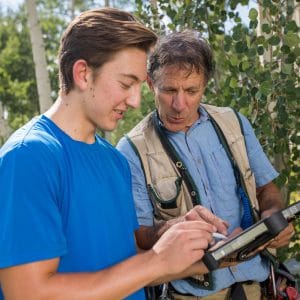*NOTE: To qualify for positions with federal agencies you will need BIO 527, BIO 528, and BIO 415, and an additional 6 credits in zoology, as well as an additional 6 credits in botany
Wildlife Ecology and Management, Undergraduate Certificate
We designed this undergraduate certificate to provide students with knowledge and skills that will make them competitive for jobs with government agencies and other organizations involved in wildlife management. The certificate will be especially useful for students pursuing undergraduate degrees in biology, environmental science, or forestry. Wildlife management is grounded in an understanding of the biology of wild animals and ecosystem ecology.
Requirements Accordion Open
To receive an undergraduate certificate (at least 15 units) at Northern Arizona University, you must complete a planned group of courses from one or more subject matter areas with a cumulative grade point average of at least 2.0.
Please be aware that federal financial aid is not available for some certificates if the certificate is pursued and completed as a stand-alone certificate (i.e., not completed concurrently with a degree program). See the "Details" tab for additional information.
Overview Accordion Closed
In addition to University Requirements:
- Complete individual plan requirements.
Students may be able to use some courses to meet more than one requirement. Contact your advisor for details.
| Minimum Units for Completion | 19 - 25 |
| Major GPA | 2.0 |
Purpose Statement
Wildlife management is concerned with sustaining wildlife populations and their habitats through science-based management and conservation. It is grounded in an understanding of the biology of wild animals and ecosystem ecology, including the habitat requirements, movements, behavior, and dynamics of wildlife populations. Students explore the taxonomy, ecology, evolution and natural history of wildlife, learning tools and techniques to study their habitat and ecosystem processes. By examining how impacts of land use and environmental management decisions affect wildlife ecosystems, students can identify approaches to influence how natural resources are used and protected. Wildlife managers typically are employed by government agencies such as the U.S. Fish and Wildlife Service or the Arizona Game and Fish Department, but also may be employed by other organizations such as environmental non-profits (e.g., The Nature Conservancy) and consulting firms.
The Undergraduate Certificate in Wildlife Ecology and Management is designed to provide students with a strong foundation in both science and management that will make them competitive for jobs with organizations involved in wildlife management and conservation. It also provides strong preparation for pursuing a graduate degree in wildlife science. The certificate will be especially useful for students pursuing Bachelor’s degrees in biology, environmental science, or forestry.
Student Learning Outcomes
- Describe the key biological and ecological principles underlying the conservation and management of wildlife species and their habitat.
- Describe the biology of one or more major groups of wildlife species (e.g., mammals, birds, fish).
- Select and apply techniques commonly used to manage and restore wildlife populations.
- Evaluate and apply scientific knowledge and research findings in the conservation and management of wildlife.
- Participate constructively in thoughtful discussions with peers, scientists, wildlife professionals, representatives of various wildlife-related interest groups, and members of the general public about a broad spectrum of wildlife- and biodiversity-related issues
Details Accordion Closed
Certificate Requirements
- Take the following 20 - 24 units with a Grade of "C" or better in each course:
- Select from the folllowing (4 units):
- Select from the following (3 units):
- Ecology Coursework - select from the following (3 - 4 units):
- Wildlife Biology - select from the following (4 -5 units):
- Zoology - select from the following (3 - 4 units):
- Botany - select from the following (3 - 4 units):
- Track for Biology BS, Ecology and Evolutionary Biology BS, and Secondary Education-Biology BSEd Majors
- Take the following 20 - 23 units with a Grade of "C" or better in each course:
* These courses may not be used to satisfy both certificate and degree requirements.
This certificate may be pursued and completed concurrently with a degree program or as a stand-alone certificate. Federal financial aid cannot be used if the certificate is completed as a stand-alone certificate.
Additional Information
Be aware that some courses may have prerequisites that you must also successfully complete. For prerequisite information, click on the course or see your advisor.
